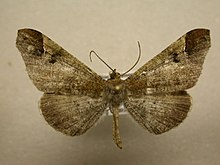| Hedylidae | |
|---|---|

| |
| Macrosoma bahiata | |
| Scientific classification | |
| Domain: | Eukaryota |
| Kingdom: | Animalia |
| Phylum: | Arthropoda |
| Class: | Insecta |
| Order: | Lepidoptera |
| Clade: | Obtectomera |
| Superfamily: | Papilionoidea |
| Family: | Hedylidae Guenée, 1857, nec. Bergh, 1895 |
| Genus: | Macrosoma Hübner, 1818 |
| Type species | |
| Macrosoma tipulata Hübner, 1818
| |
| Species | |
|
see List of species | |
| Diversity | |
| 35 currently recognised species | |
| Synonyms | |
| |
Hedylidae, the "American moth-butterflies", is a family of insects in the order Lepidoptera, representing the superfamily Hedyloidea. They have traditionally been viewed as an extant sister group of the butterfly superfamily Papilionoidea, but a 2014 phylogenetic analysis has suggested Hedylidae is a subgroup of Papilionoidea, and not a sister group, and are more accurately referred to as butterflies rather than moths.[1] They are represented by a single Neotropical genus Macrosoma with 35 currently recognized species.
- ^ Kawahara, Akito Y.; Breinholt, Jesse W. (2014-08-07). "Phylogenomics provides strong evidence for relationships of butterflies and moths". Proceedings of the Royal Society B: Biological Sciences. 281 (1788): 20140970. doi:10.1098/rspb.2014.0970. ISSN 0962-8452. PMC 4083801. PMID 24966318.